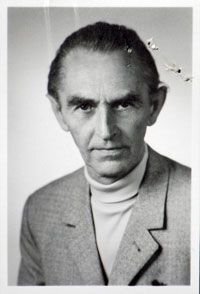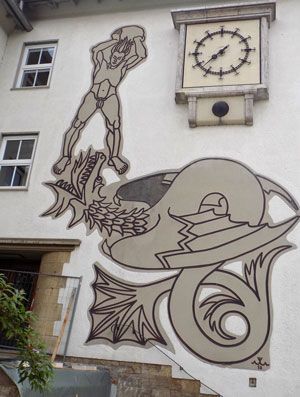WALTER HERBERT'S CEILING PAINTING IN THE INSTITUTE OF EARTH SCIENCES
(aus: Heubeck, C., (Hrsg.), 25 Jahre Institut für Geowissenschaften. Menschen, Konzepte und Ideen. Friedrich-Schiller-Universität Jena, 134 S., mit zahlr. Abbildungen, ISBN-Nr. 978-3-9818697-9-8)
Biography
Walter Herbert was born on January 26, 1908 in Henfstädt near Themar (Thuringia) as the son of the elementary school teacher Gustav Herbert and his wife Emilie and initially attended elementary school in his hometown. At Easter 1922, he transferred to the German Reconstruction School in Hildburghausen. Shortly before he took his school-leaving examination at the age of 20, his father fell seriously ill. Although Walter Herbert had already been accepted at the Dresden Art Academy for the summer semester of 1928, he had to promise his father on his deathbed that he would take up a non-artistic profession. He enrolled a few months later, on April 30, 1928, to study education, philosophy, German language and literature, and psychology at the University of Jena with the goal of becoming a teacher.

During his studies, a semester abroad (summer semester 1929) took him to Vienna. In 1931 he passed the teacher's examination. After that, he received a provisional appointment in the Thuringian elementary school service. Herbert was very interested in psychology. After only eight semesters, he completed his studies with a doctorate on the topic of "On the Psychology of Punishment." Until his defense, he worked at the Jena Psychological Institute conducting experimental research.
The oral examination for the doctorate (major in psychology, minors in philosophy and German) took place in February 1933.
A request to reduce the number of 200 required copies for financial reasons was rejected by the university. Only when the dissertation was available as a book in Würzburg and thus the publication requirement was fulfilled, the doctorate became legally valid on 27.2.1934, a full year after the examination. By this time, Herbert had married and found employment at the one-class elementary school in Horba, a village in the Rudolstadt district. He was appointed a civil servant in 1935 and in 1938 was transferred to Stützerbach (near Ilmenau) as the main teacher of the six-grade elementary school.
In May 1940 Herbert was drafted into the Wehrmacht. He served a few months in a medical company in occupied France before his unit was transferred to the Eastern Front in July 1941. There, by then a simple infantryman, he was severely wounded in 1943, which led to his mustering out in late 1944, presumably after a lengthy stay in a hospital. In December 1944 he resumed his teaching profession in Stützerbach as a 70% severely disabled person. In the course of the denazification campaign, he was summarily dismissed in October 1945 because of his former affiliation with the NSDAP. This forced him to return with his family to his parents in Henfstädt and to turn to his true vocation, art.
The first evidence of his artistic activity can be found in the immediate vicinity. From 1949 he worked as a freelance artist in Jena. Due to the high quality of the works created at the beginning of the 1950s, it can be assumed that he had already been occupied with artistic techniques for a longer period of time.
Working in Jena

In a handwritten curriculum vitae from 1957, preserved in his personnel file in the Lower Saxony State Archives, Herbert writes that he had begun "to develop his hobby into a profession through self-study and with guidance from painter friends." An essential orientation to the work and design methods of the mural painting classes of the nearby Weimar College of Architecture and Fine Arts seems obvious. Possibly he had also received inspiration from his semester abroad in Vienna. In February 1955, the commission for the fine arts at the district council issued a written commission for the artistic decoration of the Institute for Earthquake Research in Jena. Herbert had already recommended himself for the artistic implementation of scientific themes through the picture cycles on the "Development of Life on Earth" (1953) and "History of Science" (1953/54) for the ZIMET, which he had created immediately before.
From 1953 to 1957, Herbert was elected four times in a row as head of the painting and graphic arts section in the Gera district branch of the Verband Bildender Künstler Deutschlands (VBKD). This function requires professional artistic work and high esteem by the association colleagues. Herbert participated in several art exhibitions, including the 3rd Art Exhibition in Dresden, and headed the "Drawing and Painting" factory group at VEB Carl Zeiss. During this period of reconstruction and the founding of new institutes and scientific facilities, commissions for the artistic decoration of new buildings were not too rare. Herbert created sgraffiti on the facade of the Central Institute for Microbiology and Experimental Therapy (ZIMET; today the Hans Knöll Institute) and on the school Am Anger as well as secco paintings in the foyer of the ZIMET.
His main work is the stained-glass window cycle on the history of pharmacy in the headquarters of Jenapharm, which extends over six floors; see Weilandt (2008).
Die Deckenmalereien im IGW
Documents preserved from the construction history of the building on Burgweg show that the institute's director and future landlord, Prof. Gerhard Krumbach, was involved in conceptual and design aspects of the new building and, already seriously ill, was still discussing the designs with Herbert in 1955. A first written request for an appointment dates from February 28, 1955, and Krumbach gave the artist, as Herbert writes, "a completely free hand" in the design. On September 5, 1955, Herbert wrote to the construction management asking them to prepare the substrate properly, and on October 14, 1955, 50 kg of powdered casein were ordered.
The painting work took place in the winter of 1955/1956 in the shell of the building, which was decidedly cold due to installation delays and problems with the heating system.
Herbert (1981) wrote:
"The application of the boxes, tracing, and eventual painting was difficult without expedient scaffolding. On the ground floor, this work could be done standing from a plank floor on trestles provided by the workmen, likewise for the staircase ceiling. For the ceilings on the 1st and 2nd floors, the necessary plank floors could not be made. However, a two-meter wide plank walkway on trestles, which reached from wall to wall and could be moved away, was to be created. Six volunteers from my painting circle at VEB Carl Zeiß and I stood on it, pressed the two meter wide cardboard boxes against the ceiling and traced the drawing. Millimeter-precise work on the cardboard joints and tracing was achieved thanks to the usual accuracy of my helpers - despite all the difficulties.
For the painting work, which had to be carried out for the most part during the winter in a carcass without windows and doors, I devised and built, with the help of the workmen, a four-foot beam frame calculated for the working height, which was given a couch at the top by a mattress and head wedge. Without outside help, the painter could move the frame on logs. This mall couch was completed by a ladder, a studio lamp and a bar for resting the hand while painting, which rested movably on two bars nailed to the long sides of the frame. The design was tucked under rubber bands behind the headboard and could be consulted if there were any doubts about the break. The painter lay during his work on this "mobile" couch under woolen blankets and behind reed mats. These also provisionally closed the construction openings. The whole arrangement worked very well."
Escape and a new beginning
On September 7, 1957, Herbert fled hastily to the West, taking advantage of an already granted exit permit to visit his son, who was studying in Göttingen, and taking only a few documents with him. Two days earlier, he had been informed in writing by the district leadership of the VBKD of his immediate dismissal and the loss of all functions due to his insufficient political stance. This was probably due to his efforts to prevent the politicization of the association, which was becoming more and more oppressive after the failed uprising in Hungary in 1956. He had reason to believe that this ouster would result in further, harsher measures.
Herbert found employment as an elementary school teacher in Hanover the following month, was able to bring up his family, soon became a civil servant and worked as a specialist teacher for German and art education at schools in Hanover and from 1964) in Burgdorf, before retiring there in 1975.
The description of the ceiling painting
Former employees of the local institute remember that Herbert came by once - probably in October 1979 - but the unannounced visit of a West German to a state research institute of the GDR was delicate for both sides and probably lasted only minutes; at least, a contact had been established. In September 1980, he answered an inquiry from the then director of the institute, Prof. Heinz Kautzleben, who had asked him to describe the paintings. Obviously, the institute, which had been in this house for 25 years, did not have any information on this.
The cover letter accompanying his reply indicates that Herbert planned to deliver the requested description in person, but the scheduled visit to Jena did not materialize "due to known and still existing impediments," so that he did not send the detailed eight-pagepdf, 5 mb · de description until a full year later, on October 12, 1981.
It is unlikely that Herbert, who had left the Soviet zone in 1957 with only hand luggage, could have relied on documentation when writing the description of the ceiling paintings, 26 years after they were executed. All the more impressive is the richness of detail and the accuracy of the text, combined with a precise expression and style, which probably also reflects the feeling for language and the experience of the German teacher.
Walter Herbert died on 28.6.1986 in Burgdorf.
LITERATUR
BStU (Stasi Records Authority) FB 167, sheet 72, and FB 1007, A. 9.
DD-WASt (Deutsche Dienststelle - Wehrmachtsauskunftstelle für Kriegerverluste und Kriegsgefangene); information dated 3.5.2018.
Herbert, W., 1981, Letter to the Zentralinstitut für Physik der Erde, Institutsteil Jena, dated 12.10.1981..
Maaz, R., 1972, Das Institutsgebäude am Burgweg. Jena Information, März 1972.
Niedersächsisches Landesarchiv Hannover (NLA), Akte Nds. 120 Hannover Acc. 2011/057, Nr. 750 und Nr. 751 (Personalakte von Dr. Walter Herbert im Nds. Beamtendienst).
Universitätsarchiv der Friedrich-Schiller-Universität Jena, Kartei der Studierenden der Universität Jena, 1915-1935; Bestand N, Nr. 14 (Promotionsvorgang)
Weilandt, D., 2009, Jenapharm - Architektur und Kunst am Bau. Vopelius-Verlag Jena, 115 S.
THANKS
We would like to thank colleague Harald Lützner, who helped with many hints, Dr. Babett Forster, who advised in questions of artistic execution, and Dr. Busse from the Pattensen magazine of the NLA.


